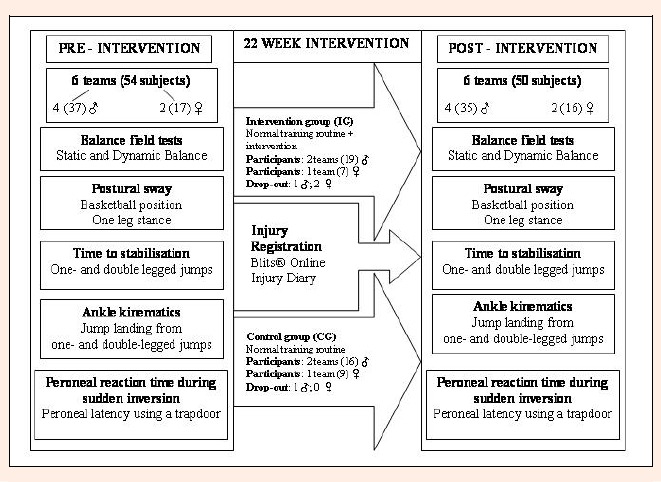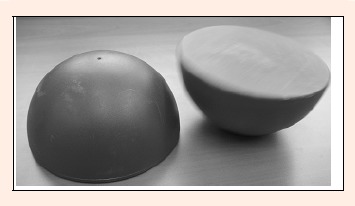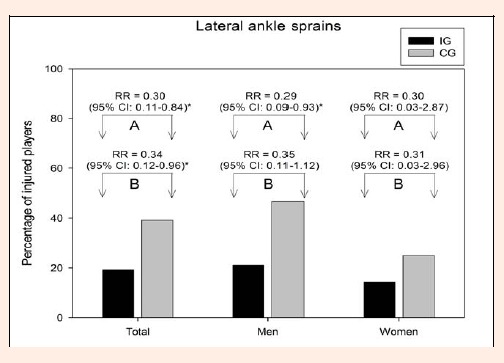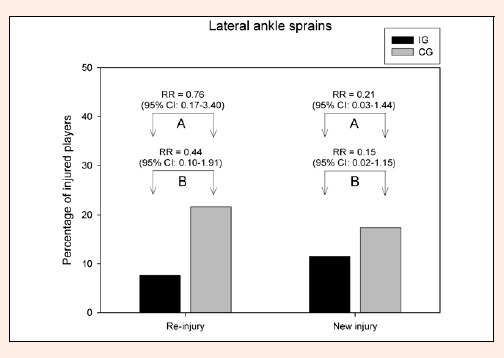Abstract
The purpose of the study was to determine the efficacy of a 22- week prescribed sports specific balance training programme on the incidence of lateral ankle sprains in basketball players. A controlled clinical trial was set up. In total 54 subjects of six teams participated and were assigned to either an intervention (IG) or a control group (CG). The IG performed a prescribed balance training programme on top of their normal training routine, using balance semi-globes. The programme consisted of 4 basketball skills each session and its difficulty was progressively thought-out. The intervention lasted 22 weeks and was performed 3 times a week for 5 to 10 minutes. Efficacy of the intervention on the incidence of lateral ankle sprains was determined by calculating Relative Risks (RR, including their 95% Confidence Intervals or CI) and incidence rates expressed per 1000h. RR (95% CI) showed a significantly lower incidence of lateral ankle sprains in the IG compared to the CG for the total sample (RR= 0.30 [95% CI: 0.11-0.84]) and in men (RR= 0.29 [95% CI: 0.09-0.93]). The difference in RR was not confirmed when examining the incidence rates and their 95%CI’s, which overlapped. The risk for new or recurrent ankle sprains was slightly lower in the IG (new: RR= 0.76 [95% CI: 0.17-3.40]; re-injury: RR= 0.21 [95% CI: 0.03-1.44]). Based on these pilot results, the use of balance training is recommended as a routine during basketball activities for the prevention of ankle sprains.
Key points.
We could not establish a true preventive effect of the training, most likely due to the low sample size.
Although not significant, large differences in incidence rates were found between the intervention and control group and relative risks showed a significant difference.
Our results were in line with previous results and therefore proprioceptive balance training should become a part of the training routine.
Concerning this study and the literature, proprioceptive balance training should last 5-15 minutes and should be performed 2 to 3 times a week.
Key Words: Injury prevention, sports, proprioceptive training, ankle injury
Introduction
As in a wide variety of sports, including basketball, sprains of the lateral ankle ligaments are the most common sports injuries (Cumps et al., 2007; Gomez et al., 1996; Henry et al., 1982; Hickey et al., 1997; Huguet and Begué, 1998; McKay et al., 2001; Meeuwisse et al., 2003; Sitler et al., 1994; Surve et al., 1994; Zelisko et al., 1982). Although a history of ankle sprains is the best predictor for the occurrence of ankle injuries, not all studies could confirm this finding in basketball (Cumps et al., 2007; McKay et al., 2001; Meeuwisse et al., 2003). The considerable risk of re-injury subsequent to a lateral ankle sprain, has previously been reported in other sports (Ekstrand and Tropp, 1990; Holme et al., 1999; McKay et al., 2001). Although basketball is not considered to be a contact sport, a high number of ankle sprains is a result of landing on an opponent’s foot or are caused by a sudden change of direction (Cumps et al., 2007; Self and Paine, 2001; Thacker et al., 1999).
Research concerning the epidemiology of basketball injuries and their risk factors is rapidly growing and is well examined in literature while studies examining the impact of prevention on injury occurrence are also on the rise nowadays, and most of the studies performed used cluster randomization designs (Bahr et al., 1997; McGuine and Keene, 2006; Söderman et al., 2000; Wedderkopp et al., 1999; 2003; Verhagen et al., 2004). The high incidence of ankle sprains and their negative consequences for future sports participation, call for preventive measures.
External support (like e.g. taping/orthosis) is the most common preventive method among athletes and many studies have been done to establish its effectiveness. Randomised clinical trials have reported that the use of external support reduces the incidence of ankle sprains (Barrett et al., 1993; Garrick and Requa, 1973; Sitler et al., 1994; Surve et al., 1994; Tropp et al., 1985). Not only does orthosis provide mechanical support, its main merit is the improvement of the proprioceptive function of a previously injured ankle (Surve et al., 1994). Bracing and taping have negative side effects (uncomfortable if not fitted properly, skin irritation, relatively high costs, etc.) (Verhagen et al., 2001). These negative side effects justify the development of an alternative method of prevention.
Proprioception training is widely used in rehabilitating ankle sprains to re-strengthen the muscles and ligaments and to restore proprioception of the damaged structures (Gauffin et al., 1998; Konradsen and Ravn, 1991). Proprioceptive training involves the use of devices such as e.g. the tilt board, which is considered to be unique because of its stimulation of multiple planes of ankle movement on a weight bearing foot (Sheth et al., 1997). In literature, balance training has also been suggested as an alternative for taping or bracing in the prevention of ankle sprains (Bahr et al., 1997; McGuine and Keene, 2006; Petersen et al., 2005; Söderman et al., 2000; Stasinopoulos, 2004; Tropp et al., 1985; Verhagen et al., 2004; Wedderkopp et al., 1999). These balance training measures appear to be as effective as braces and tape (mainly) in the prevention of recurrent ankle sprains, yet do not seem to come with the above mentioned negative side effects (Bahr et al., 1997; McGuine and Keene, 2006; Tropp et al., 1985; Verhagen et al., 2004).
Since ankle sprains are very common in basketball and because previous studies have shown that balance training is a promising preventive tool for ankle sprains, the purpose of this controlled clinical pilot trial was to examine prospectively whether a prescribed in-season balance training programme of 22 weeks, based on basketball skills, is efficacious in the prevention of ankle sprains with basketball players.
Methods
Study design
A controlled clinical pilot trial was set up with both a control (CG) and an intervention (IG) group of mixed elite youth and young senior basketball players. The study has been conducted in accordance with the institutional ethical rules for human research and following the Declaration of Helsinki for Medical Research involving human subjects. Both pre- and post-intervention several proprioception measures were performed and are mentioned in Figure 1, to be informative and complete concerning the study-design.
Figure 1.

The complete study-design is presented, showing the number of participants. Both before and after the intervention, different proprioception or balance tests for each subject were measured.
Subjects
Initially, a total of 54 subjects, who all signed a written informed consent, took part in the study. The 6 teams were assigned to either the CG or IG, depending on the feasibility of following-up the execution of the intervention programme. Figure 1 shows the number of participants per group. Our purpose was to carry out a pilot trial, which means we never had any intention of including more teams or subjects into the study. Consequently an a priori power analysis was not performed.
Intervention
The IG followed a prescribed (Table 1) basketball specific balance training programme, using balance semi-globes (Figure 2) on top of their normal training routine. The programme lasted 22 weeks and was performed 3 times (session) a week for 5 to 10 minutes during the warming-up. All skills performed during the intervention programme were basketball specific: each session consisted of a stance exercise, an Aberdeen (ball handling without dribbling), a dribbling and a passing drill. The intervention programme was gradually increased with respect to difficulty and safety of the balance skill and was divided into 4 different phases determined by the position of the semi-globes and feet. The CG followed their normal training routine and were not subjected to any additional intervention.
Table 1.
The 22 week prescribed balance training programme is presented.
| Session 1 Eyes open focused on ball |
Session 2 Eyes open not focused on ball |
Session 3 Eyes closed |
|||
|---|---|---|---|---|---|
| Phase 1: WITHOUT SG | Week 1 | Basketball position: feet next to each other shoulder width1 | |||
|
Stance Dribbling Aberdeen Passing1 |
Sweeps (= keeping the ball alive) Push & Pull dribble (= forward – backward next to feet) Turn ball around head, trunk and legs (figure 8) Hands up: straight and diagonal passing |
||||
| Week 2 | Tandem stance: one foot behind the other on a straight line 1 | ||||
|
Stance Dribbling Aberdeen Passing1 |
Sweeps Power dribble high and low and changing hand between the legs Turn ball around head, trunk and legs (figure 8) Hands up: with 2 balls straight passing |
||||
| Week 3 | One leg stance | ||||
|
Stance Dribbling Aberdeen Passing1 |
Sweeps Push & Pull dribble Figure 8 between the legs Bad passing with tennis ball |
||||
| Week 4 | Jumping tasks 2, 3 | ||||
|
Stance Dribbling Aberdeen Passing1 |
Mirror the teammate Push & Pull dribble + jump into pass Figure 8 between the legs + jump (= scissors) Jump to bad pass with tennis ball |
||||
| Phase 2: SG FLAT SIDE DOWN | Week 5/6/7/8 |
Basketball position: feet next to each other shoulder width 1 | |||
|
Stance Dribbling Aberdeen Passing1 |
Stance / Sweeps / Sweeps + Mirror the ball2 / Ball fight Power dribble high & low / Push & Pull dribble / Hockey dribble / L-dribble Around trunk / Figure 8 between legs / Head-trunk-figure 8 / Scissors Chest pass / Week 1 / Week 2 / Week 3 |
||||
| Week 9/10/11/12 |
Tandem stance: one foot behind the other on a straight line 1 | ||||
|
Stance Dribbling Aberdeen Passing1 |
Stance / Sweeps / Sweeps + Mirror the ball2 / Ball fight Power dribble high & low / Push & Pull dribble / Hockey dribble / L-dribble Around trunk / Figure 8 between legs / Head-trunk-figure 8 / Scissors Chest pass / Week 1 / Week 2 / Week 3 |
||||
| Week 13/14/15/1 |
One leg stance | ||||
|
Stance Dribbling Aberdeen Passing1 |
Stance / Sweeps / Sweeps + Mirror the ball2 / Ball fight Power dribble high & low / Push & Pull dribble / Hockey dribble / L-dribble Around trunk / Figure 8 between legs / Head-trunk-figure 8 / Scissors Chest pass / Week 1 / Week 2 / Week 3 |
||||
| Phase 3: SG GLOBE SIDE DOWN |
Week 17/18 |
Basketball position: feet next to each other shoulder width 1 | |||
|
Stance Dribbling Aberdeen Passing1 |
Stance / Sweeps Push & Pull dribble / Power dribble high & low Around trunk / Figure 8 between legs Chest pass / Week 1 |
||||
| Week 19/20 |
One leg stance | ||||
|
Stance Dribbling Aberdeen Passing1 |
Stance / Sweeps Push & Pull dribble / Power dribble high & low Around trunk / Figure 8 between legs Chest pass / Week 1 |
||||
| Phase 4: SG FLAT SIDE DOWN |
Week 21 | Dynamic exercises 2 | |||
|
Stance Dribbling Aberdeen Passing1 |
Walk on 10 SG Walk on 10 SG and Power dribble high & low Walk on 10 SG and turn ball around trunk Walk on 10 SG and chest pass |
||||
| Week 22 | Dynamic exercises 2 | ||||
|
Stance Dribbling Aberdeen Passing1 |
Walk on 10 SG + Shot Walk on 10 SG and Power dribble high & low + Shot Walk on 10 SG and turn ball around trunk + Shot Walk on 10 SG and chest pass + Shot |
||||
1 On the ball of the feet;
2 Eyes open;
3 Dynamic exercise (session 1: 2 feet together; session 2: from one foot to the other; session 3: one foot); SG = balance semi-globes.
Figure 2.

The balance semi-globes used to perform the intervention programme. Balance semi-globes have a height of 8cm and a diameter of 15cm. 2 semi-globes (€ 5.00 per semi-globe) were provided for each player to complete the balance programme.
Injury registration
The Blits® Online Injury Diary (www.blits.org) was used to fill out all injuries sustained, mainly focusing on those ankle sprains where the lateral ligament(s) were damaged and which occurred during all sports activities which enhance basketball performance. An ankle inversion sprain with damage to the lateral ligament(s) was reported if it was acute in nature, with a sudden, direct cause/onset, requiring at least minimal (medical) care e.g. ice, tape, etc., and if it caused the player to skip at least 1 training or game session. Muscle cramps and mild bruises were excluded from the definition (Cumps et al., 2007).
Weekly exposure sheets were developed to determine exposure time of each individual separately and to collect data on the type of activity and its duration. Injury incidence was expressed per 1,000 hours of exposure, taking into account the hours spent on basketball activities (A) and the hours spent on all sports activities enhancing basketball performance (B). The players marked whether or not they stuck with the intervention programme and provided a reason for any occasional absences (e.g. no activity scheduled, illness, injury, another reason).
Prior to the start of the intervention, each participant completed the Blits® Online Injury Diary by providing demographic data, injury history, current health status and activity level. Data on previously sustained ankle sprains was collected for both ankles separately by answering the following question: ‘did you ever sustain an ankle sprain, injuring the lateral ligament(s), which resulted in complaints such as pain, swelling and stiffness which lasted for at least 3 weeks and forcing you to interrupt either your professional life, sports activities, hobbies or other activities?’.
Supervision
Observer designates (OD) were appointed to control injury registration, exposure measurement and the execution of the intervention programme. The ODs were a member of both the research team and a participating basketball team. They did not in any case interfere with the balance training, but only checked whether the programme was executed and whether the required forms were adequately completed by the players (e.g. exposure time forms and the injury registration).
Statistical analysis
The statistical analysis was performed using SPSS 14.0 (2005 Inc., Chicago, Illinois). The difference in demographic data between the 2 groups was examined using the Independent samples t-tests (p < 0.05). Relative Risks (RR) and their 95% Confidence Intervals (CI) were calculated, using a Microsoft Excel® template, to determine the efficacy, not the effectiveness, of the balance training programme for the total sample, i.e. both for subjects with previously or recently sustained lateral ankle sprains. We also took a closer look at the incidence rates per 1,000 hours, including 95%CI in order to investigate the effect of the balance training programme on the incidence of ankle sprains.
Results
Subjects
The demographic data are presented in table 2. The CG and IG did not differ significantly with respect to age, weight and BMI (Independent t-test; p < 0.05). There was however a significant difference in the height of the participants of the two groups (Independent t-test; p < 0.05). In total, 4 players dropped out of the study. One male and 1 female player of the IG quit their team due to disagreements with their coaches and 1 female player interrupted her participation for personal reasons. Of the CG, 1 male player did not show up anymore during the basketball activities for unknown reasons. They were excluded from further analysis and are not mentioned in Table 2, since they did not complete the 22 week intervention period and/or injury data were incomplete or missing.
Table 2.
Demographic data (age, height, weight and BMI) is presented for both the IG and CG and for men and women separately. Data are means (±SD).
| n | Age (y) | Height (m) | Weight (kg) | BMI (kg·m-2) | |
|---|---|---|---|---|---|
| IG (total) | 26 | 17.7 (3.9) | 1.90 (.08) * | 77.1 (10.3) | 21.5 (2.0) |
| IG (men) | 19 | 16.6 (1.3) | 1.91 (.07) § | 79.2 (10.0) | 21.6 (2.1) |
| IG (women) | 7 | 20.7 (7.4) | 1.83 (.08) | 71.2 (10.0) | 21.1 (1.5) |
| CG (total) | 24 | 18.0 (2.7) | 1.84 (.08) * | 72.4 (9.4) | 21.5 (2.4) |
| CG (men) | 15 | 17.0 (1.8) | 1.86 (.08) § | 72.7 (8.8) | 21.1 (2.1) |
| CG (women) | 9 | 19.8 (3.0) | 1.79 (.05) | 71.9 (11.0) | 21.5 (2.4) |
IG = intervention group, CG = control group.
* p < 0.05 compared with CG (total),
§ p < 0.05 compared with CG (men).
Efficacy on lateral ankle sprains
Taking into account all the hours spent on activities enhancing basketball performance, the overall incidence of ankle sprains was 3.54/1,000 hours (95% CI: 1.23-5.85) in the CG and 1.19/1,000 hours (95% CI: 0.15-2.25) in the IG. The incidence rates and the 95% CI’s did not show any effect of the intervention, which can be explained by the low number of subjects included in the study. However, the RR (0.34 [95% CI: 0.12-0.96]) showed a significantly lower risk for the IG when the total exposure time was taken into account. The same result was found when considering the hours spent on basketball activities only (RR = 0.30 [95% CI: 0.11-0.84]). This revealed an incidence of 4.09/1,000 hours (95% CI: 1.42-6.76) for the CG and 1.22/1,000 hours (95% CI: 0.15-2.29) for the IG. When analysed for men and women separately, we could not find any significant differences in the incidence of ankle sprains between the IG (women: 0.83 [95% CI: -0.79-2.44]; men: 1.39 [95% CI: 0.03-2.75]) and the CG (women: 2.76 [95% CI: -1.06-6.58]; men: 4.74 [95% CI: 1.23-8.26]), nor for women (RR = 0.30 [95% CI: 0.03-2.87]), nor for men (RR = 0.29 [95% CI: 0.09-0.93]). Although not significant, highest incidence rates were found in the CG and again in men RR showed a significant difference. Only the time exposed to basketball activities was taken into consideration for the determination of the incidence rates presented here in this text. Figure 3 presents the percentages of injured players of the CG and the IG for men and women combined and for men and women separately.
Figure 3.

Percentage of players with a lateral ankle sprain is presented for both men and women separately. Relative risks (95% CI) are shown taking into account the hours spent on basketball activities only (A) and the hours spent on sports activities executed to enhance basketball performance (e.g. strength training) (B).
New injury versus re-injury
In the IG, 20 ankles in 26 subjects (38.5% of the ankles) were injured previously versus 22 ankles in 24 subjects (45.8% of the ankles) in the CG. Of the total number of lateral ankle sprains registered during the study, 50.0% were of new onset (60.0% in IG; 44.4% in CG). There were no significant differences for the incidence of re-injuries, nor for the total amount of hours (IG: 0.44 [95% CI: -0.42-1.30]; CG: 3.00 [95% CI: 0.37-5.63]), nor for the hours spent on basketball activities only (IG: 0.36 [95% CI: -0.34-1.05]; CG: 1.72 [95% CI: 0.21-3.22]).
Taking into account the time exposed to basketball, incidence for new injuries was 0.78 (95% CI: -0.10-1.76) for the IG and 1.03 (95% CI: 0.03-2.03) for the CG. Figure 4 shows the percentages of players with a new and re-injury and RR with 95% CI.
Figure 4.

Relative risks and their 95% CI are presented for new and recurrent lateral ankle sprains, taking into account the number of basketball exposure hours (A) and the total number of exposure hours (B).
Discussion
The main purpose of this study was to determine the efficacy of the 22-week prescribed balance training programme on the incidence of lateral ankle sprains. Because it was our objective to perform a pilot trial a small sample size was used. Although we used a small sample size, the RR (95% CI) clearly showed a significantly lower incidence of ankle sprains in the IG compared to the CG for the total sample and in men after balance training. The same result could not be found by the calculated incidence rates (95% CI) because we were unable to accurately measure the incidence rate for both groups due to the low number of subjects. This low number of subjects causes a large spread between the lower and upper 95% CI. A post-hoc power analysis (β= 0.90; α= 0.05) revealed that a sample of 113 subjects was necessary to prove a significant difference between the IG and CG when using incidence rates (95% CI).
The intervention programme was designed based on information of injury mechanisms and effective prevention strategies as learned from previous studies. It was developed with an emphasis on elements that could be implemented by coaches. A prevention protocol requiring active participation from physicians or physical therapists or expensive equipment would limit its potential for future use. For that reason, the prescribed balance training programme was developed by both a top level coach, for the sports specific issues, and a sports physical therapist to ensure that the exercises were well thought through and built up gradually. To establish the motivation of the coaches sports specific issues were integrated, which led to 4 basketball specific items being incorporated in each session (stance exercise, Aberdeen, dribbling and passing drill).
The choice for balance semi-globes has grown from previous research which revealed that a vast majority of ankle sprains are caused by players landing on another player’s foot (Cumps et al., 2007; Self and Paine, 2001; Thacker et al., 1999). The semi-globe shape approaches the shape of a player’s foot more than wobble boards do and is less expensive (€ 10.00 per player or per 2 semi-globes).
Verhagen et al., 2005 showed that balance training with balance boards is a cost-effective preventive intervention. We did not investigate the cost-effectiveness, but it can be assumed that since balance semi-globes are less expensive than balance boards, a large-scale implementation of balance training with balance semi-globes will result in an even higher cost-efficiency.
Because of the low number of subjects and because we wanted to avoid contamination, we felt that it would not be possible to randomise the individuals to either the CG or IG. To avoid contamination it is necessary to divide teams in either a CG or IG. We also chose not to use the cluster-sampling randomisation method, because it also would have led to selection bias. Analysis by a cluster sampling method gives the opportunity to analyse the data, while taking a team specific risk into account. Unfortunately, the number of teams (n = 6) is too low for proper analysis by means of cluster sampling. Randomisation would have been detrimental to the supervision, which was much more feasible in the teams appointed to the IG. In our study, both groups were similar where age, weight, BMI and level of play (at the end of the season, ranked in a successive order in the same division) were concerned, which we hope limited the selection bias. There was a significant difference in the height of the CG en IG group members, yet this has previously not been identified as a risk factor for ankle sprains (Beynnon et al., 2003; McKay et al., 2001; Wedderkopp et al., 2003). Furthermore, we chose control above randomisation in order to determine the efficacy (maximal achievable effect).
When only taking into account recurrent ankle sprains, we did not find any effect of the intervention. The incidence rate in the CG was higher than in the IG for both the new and the re-injuries, although not significant. The lack of a significant difference is most likely down to the small size of the subgroups - consisting of subjects with or without previous ankle sprains - which has probably led to a type β error. Most studies show that the effects of balance training are mainly seen in players with previous injuries (Bahr et al., 1997; McGuine and Keene, 2006; Stasinopoulos, 2004; Tropp et al., 1985; Verhagen et al., 2004).
We can draw no conclusions towards the long-term effects of balance training. Follow-up during more than one season in this small number of teams might result in a high amount of drop-out, since players and coaches are free to switch teams between 2 seasons. Most authors have investigated the effect of balance training during one season without any follow-up in the next season (McGuine and Keene, 2006; Petersen et al., 2005; Söderman et al., 2000; Stasinopoulos, 2004; Tropp et al., 1985; Verhagen et al., 2004; Wedderkopp et al., 1999; 2003). Only Bahr et al., 1997 performed a 3-season phase intervention. During the first season, injury registration was performed, during the second season the intervention programme was introduced by means of a theoretical and practical session. The third season, the prevention programme was outlined in a booklet, which was distributed to all players before the season in order to reinforce the information given during the previous season. When comparing the first to the third and the second to the third season, the incidence of ankle injuries was significantly lower. Seeing these results we can conclude that introducing the intervention programme will reduce the number of ankle injuries. Whether players are at higher risk when withdrawing from balance training remains to be seen. Most of the investigators combined balance training with either functional training, technical training or jump training, which makes it impossible to determine which training is responsible for the preventive effect (Bahr et al., 1997; Petersen et al., 2005; Wedderkopp et al., 1999).
The intervention in our study had to be performed 3 times a week for 22 weeks of the season, for 5 to 10 minutes per session. The frequency and duration of balance training differ among studies, but in the majority of investigations the programme is performed during the season for 5, 10 or 15 minutes per session, although the number of sessions tends to vary between the studies (Bahr et al., 1997; McGuine and Keene, 2006; Petersen et al., 2005; Söderman et al., 2000; Stasinopoulos, 2004; Tropp et al., 1985; Verhagen et al., 2004; Wedderkopp et al., 1999; 2003).
As mentioned before, we choose control over randomisation to determine the efficacy rather than effectiveness, which is only feasible in rather small samples or with a high amount of personnel. To succeed in controlling exposure measurement, injury registration and execution of the intervention programme, we appointed ODs. This resulted in a low drop-out percentage (7.4%) which was caused by external factors alienated from the study itself. Thanks to the ODs, we have detailed information on how the coaches and players complied with the intervention. In the present prospective study, injuries were measured by means of self-report. The ODs were either physical therapists or physical education teachers and checked whether all injuries were registered, which is why there were hardly misclassifications of injuries at all.
Injury awareness is believed to be a confounding factor in sports injury research because it causes players to adjust their behaviour in practicing sports (Verhagen et al., 2004). Same as with the study of Verhagen et al., 2004 the effect of injury awareness was minimized by giving both groups exactly the same information on the background and procedures of the study at baseline. The only difference in information was the instruction on the balance training programme, which was kept from the CG (Verhagen et al., 2004).
Conclusion
Our study showed lower incidence rates of lateral ankle sprains in the IG compared to the CG, although not significant due to low number of subjects included in the study. The relative risks however did show significant lower risks of ankle sprains in the IG compared to the CG. These results are in line with studies who previously investigated the effect of balance training on the incidence of ankle sprains (McGuine and Keene, 2006; Petersen et al., 2005; Söderman et al., 2000; Stasinopoulos, 2004; Tropp et al., 1985; Verhagen et al., 2004; Wedderkopp et al., 1999; 2003). Most of these studies revealed that balance training mainly showed to be preventative for recurrent ankle sprains (Bahr et al., 1997; McGuine and Keene, 2006; Stasinopoulos, 2004; Tropp et al., 1985; Verhagen et al., 2004). Given our results and the results mentioned in literature, we highly recommend the implementation of proprioceptive balance training to prevent ankle sprains in basketball players.
Acknowledgement
The authors gratefully thank all the players, coaches and ODs (Anne Winkelmans, Daphne Van Dessel, Kim Verbeeck) for their enthusiastic cooperation during the complete research project. Our thanks also go to Els Saelens for proofreading the English text. This work was financially supported by the Flemish Government by the establishment of the Policy Research Center Sports, Physical Activity and Health.
Biographies

Elke Cumps
Employment
Vrije Universiteit Brussel, Faculty of Physical Education and Physical Therapy, Department of Human Physiology and Sports Medicine - Policy Research Center Sports, Physical Activity and Health, Belgium.
Degree
PhD-student.
Research interests
Sports injury surveillance and prevention, sports medicine.
E-mail: ecumps@vub.ac.be

Evert Verhagen
Employment
Department of Public and Occupational Health, EMGO-Institute, VU University Medical Centre, The Netherlands.
Degree
PhD.
Research interests
Sports medicine.
E-mail: e.verhagen3@chello.nl

Romain Meeusen
Employment
Vrije Universiteit Brussel, Faculty of Physical Education and Physical Therapy, Department of Human Physiology and Sports Medicine, Belgium .
Degree
Professor.
Research interests
Exercise physiology, brain and exercise, overtraining syndrome, sports injury surveillance, sports medicine.
E-mail: rmeeusen@vub.ac.be
References
- 1.Bahr R., Bahr I. (1997) Incidence of acute volleyball injuries: a prospective cohort study of injury mechanisms and risk factors. Scandinavian Journal of Medicine & Science in Sports 7, 166-171 [DOI] [PubMed] [Google Scholar]
- 2.Bahr R., Lian O., Bahr I. (1997) A twofold reduction in the incidence of acute ankle sprains in volleyball after the introduction of an injury prevention programme: a prospective cohort study. Scandinavian Journal of Medicine & Science in Sports 7, 172-177 [DOI] [PubMed] [Google Scholar]
- 3.Barrett J., Tanji J., Drake C., Fuller D., Kawasaki R., Fenton R. (1993) High-versus low-top shoes for the prevention of ankle sprains in basketball players. A prospective randomised study. American Journal of Sports Medicine 21, 582-585 [DOI] [PubMed] [Google Scholar]
- 4.Beynnon B., Renström P., Alosa D., Baumhauer J., Vacek P. (2003) Ankle ligament injury risk factors: A prospective study of college athletes. Journal of Orthopaedic Research 19, 213-220 [DOI] [PubMed] [Google Scholar]
- 5.Beynnon B., Murphy D., Alosa D. (2002) Predictive factors for lateral ankle sprains: a literature review. Journal of Athletic Training 37, 376-380 [PMC free article] [PubMed] [Google Scholar]
- 6.Cumps E., Verhagen E., Meeusen R. (2007) Prospective epidemiological study of basketball injuries during one competitive season: Ankle sprains and overuse knee injuries. Journal of Sports Science and Medicine 6, 204-211 [PMC free article] [PubMed] [Google Scholar]
- 7.Ekstrand J., Tropp H. (1990) The incidence of ankle sprains in soccer. Foot & Ankle International 11, 41-44 [DOI] [PubMed] [Google Scholar]
- 8.Garrick J., Requa R. (1973) Role of external support in the prevention of ankle sprains. Medicine and Science in Sports 5, 200-203 [PubMed] [Google Scholar]
- 9.Gauffin H., Tropp H., Odenrick P. (1998) Effect of ankle disk training on postural control in patients with functional instability of the ankle joint. International Journal of Sports Medicine 9, 141-144 [DOI] [PubMed] [Google Scholar]
- 10.Gomez E., Delee J., Farney W. (1996) Incidence in Texas girls’ high school basketball. American Journal of Sports Medicine 24, 684-687 [DOI] [PubMed] [Google Scholar]
- 11.Henry J., Lareau B., Neigut D. (1982) The injury rate in professional basketball. American Journal of Sports Medicine 10, 16-18 [DOI] [PubMed] [Google Scholar]
- 12.Hickey G, Fricker P, McDonald W. (1997) Injuries in young elite female basketball players over a six-year period. Clinical Journal of Sport Medicine 7, 252-256 [DOI] [PubMed] [Google Scholar]
- 13.Holme E., Magnusson S., Becher K., Bieler T., Aagaard P., Kjaer M. (1999) The effect of supervised rehabilitation on strength, postural sway, position sense and re-injury risk after acute ankle ligament sprain. Scandinavian Journal of Medicine & Science in Sports 9, 104-109 [DOI] [PubMed] [Google Scholar]
- 14.Huguet J., Begué J. (1998) The pathology of basketball. Sports & Medicine Today 1, 72-76 [Google Scholar]
- 15.Konradsen L., Ravn J. (1991) Prolonged peroneal reaction time in ankle instability. International Journal of Sports Medicine 12, 290-292 [DOI] [PubMed] [Google Scholar]
- 16.McGuine T., Keene J. (2006) The effect of a balance training programme on the risk of ankle sprains in High School athletes. American Journal of Sports Medicine 34, 1103-1111 [DOI] [PubMed] [Google Scholar]
- 17.McKay G., Goldie P., Payne W, Oakes B. (2001) Ankle injuries in basketball: injury rate and risk factors. British Journal of Sport Medicine 35, 103-108 [DOI] [PMC free article] [PubMed] [Google Scholar]
- 18.Meeuwisse W., Sellmer R., Hagel B. (2003) Rates and risks of injury during intercollegiate basketball. American Journal Sports Medicine 31, 379-385 [DOI] [PubMed] [Google Scholar]
- 19.Milgrom C., Shlamkovitch N., Finestone A. (1991) Risk factors for lateral ankle sprain: a prospective study among military recruits. Foot & Ankle International 12, 26-30 [DOI] [PubMed] [Google Scholar]
- 20.Petersen W., Braun C., Bock W., Schmidt K., Weimann A., Drescher W., Eiling E., Stange R., Fuchs T., Hedderich J., Zantop T. (2005) A controlled prospective case control study of a prevention training programme in female team handball players: the German experience. Archives of Orthopaedic and Trauma Surgery 125, 614-621 [DOI] [PubMed] [Google Scholar]
- 21.Self B., Paine D. (2001) Ankle biomechanics during four landing techniques. Medicine and Science in Sports and Exercise 33, 1338-1344 [DOI] [PubMed] [Google Scholar]
- 22.Sheth P., Yu B., Laskowski R., An K. (1997) Ankle disk training influences reaction time of selected muscles in a simulated ankle sprain. American Journal of Sports Medicine 22, 538-543 [DOI] [PubMed] [Google Scholar]
- 23.Sitler M., Ryan J., Wheeler B., McBride J., Arciero R., Anderson J., Horodyski M. (1994) The efficacy of a semirigid ankle stabilizer to reduce acute ankle injuries in basketball. A randomised clinical study at West Point. American Journal Sports Medicine 22, 454-461 [DOI] [PubMed] [Google Scholar]
- 24.Söderman K., Werner S., Pietilä T., Engstrom B., Alfredson H. (2000) Balance board training prevention of traumatic injuries of the lower extremities in female soccer players?. A prospective randomised intervention study. Knee Surgery Sports Traumatology Arthroscopy 38, 356-363 [DOI] [PubMed] [Google Scholar]
- 25.Stasinopoulos D. (2004) Comparison of three preventive methods in order to reduce the incidence of ankle inversion sprains among female volleyball players. British Journal of Sports Medicine 38, 182-185 [DOI] [PMC free article] [PubMed] [Google Scholar]
- 26.Surve I., Schwellnuss M., Noakes T., Lombard C. (1994) A fivefold reduction in the incidence of recurrent ankle sprains in soccer players using sport-stirrup othosis. American Journal Sports Medicine 22, 601-606 [DOI] [PubMed] [Google Scholar]
- 27.Thacker S., Stroup D., Branche C., Gilchrist J., Goodman R., Weitman E. (1999) The prevention of ankle sprains in sports. A systematic review of the literature. American Journal of Sports Medicine 27, 753-759 [DOI] [PubMed] [Google Scholar]
- 28.Tropp H., Askling C., Gillquist J. (1985) Prevention of ankle sprains. American Journal of Sports Medicine 21, 259-261 [DOI] [PubMed] [Google Scholar]
- 29.Verhagen E., van der Beek A., Twisk J., Bouter L., Bahr R., van Mechelen W. (2004) The effect of a proprioceptive balance board training programme for the prevention of ankle sprains. A prospective controlled trial. American Journal of Sports Medicine 32, 1385-1393 [DOI] [PubMed] [Google Scholar]
- 30.Verhagen E., van der Beek A., van Mechelen W. (2001) The effect of preventive measures on the incidence of ankle sprains. Clinical Journal of Sport Medicine 31, 667-677 [DOI] [PubMed] [Google Scholar]
- 31.Verhagen E., van Tulder M., van der Beek A., Bouter L., van Mechelen W. (2005) An economic evaluation of a proprioceptive balance board training programme for the prevention of ankle sprains in volleyball. British Journal of Sports Medicine 39, 111-115 [DOI] [PMC free article] [PubMed] [Google Scholar]
- 32.Wedderkopp N., Kaltoft M., Lundgaard B., Rosendahl M., Froberg K. (1999) Prevention of injuries in young female players in European team handball. A prospective intervention study. Scandinavian Journal of Medicine & Science in Sports 9, 41-47 [DOI] [PubMed] [Google Scholar]
- 33.Wedderkopp N., Kaltoft M., Holm R., Froberg K. (2003) Comparison of two intervention programmes in young female players in European handball - with and without ankle disc. Scandinavian Journal of Medicine & Science in Sports 13, 371-375 [DOI] [PubMed] [Google Scholar]
- 34.Zelisko J., Noble H., Porter M. (1982) A comparison of men’s and women’s professional basketball injuries. American Journal Sports Medicine 10, 297-299 [DOI] [PubMed] [Google Scholar]


